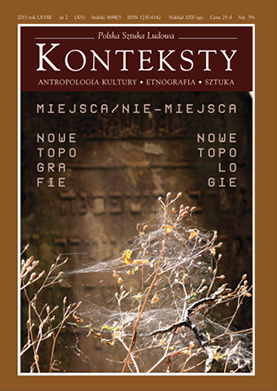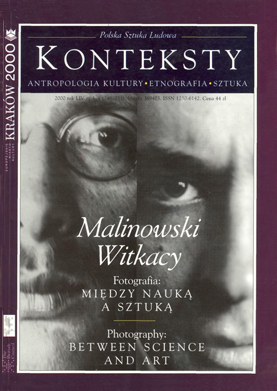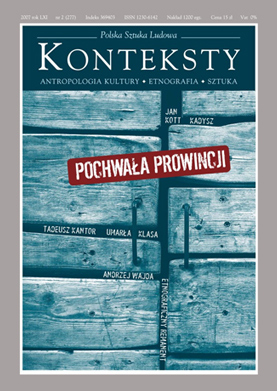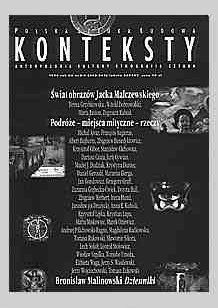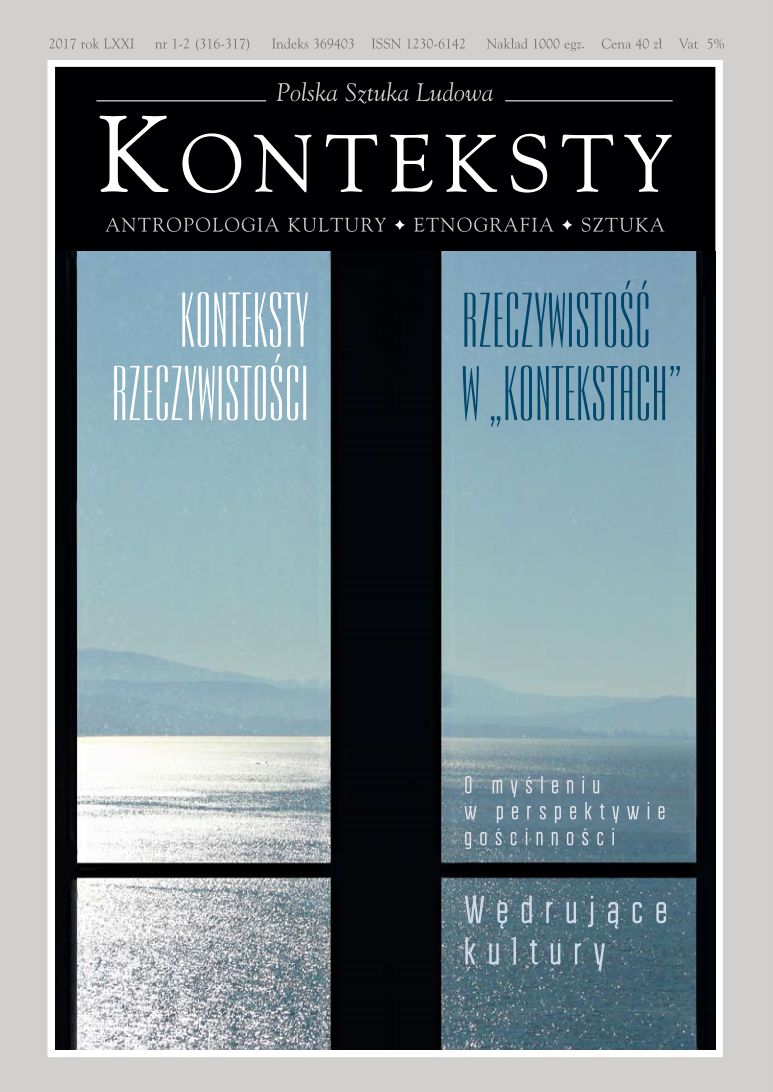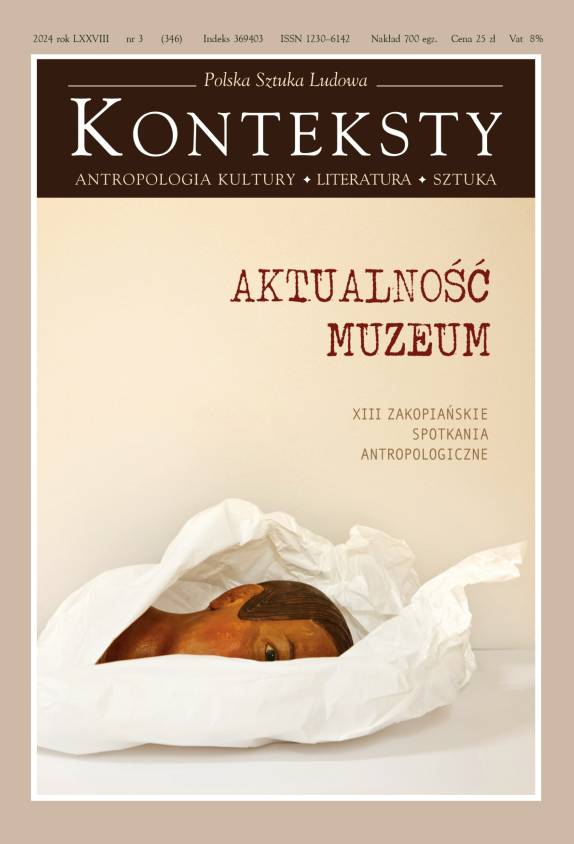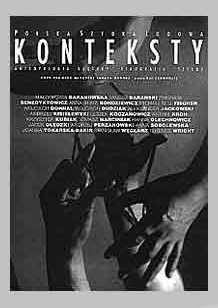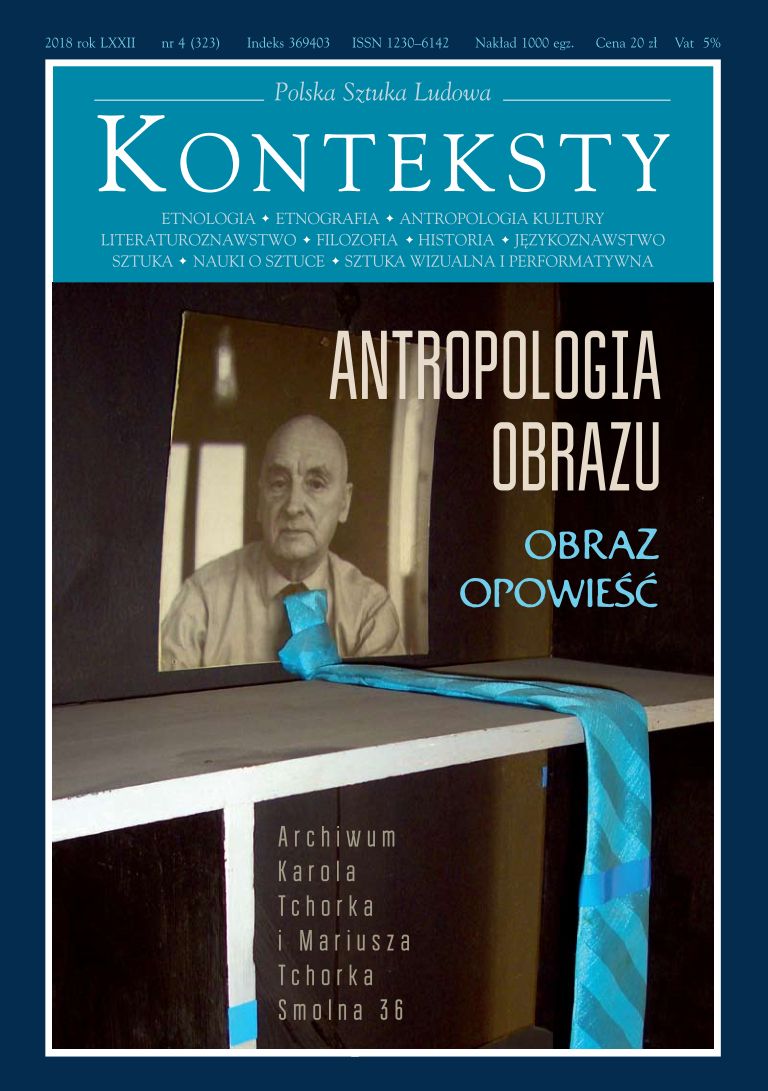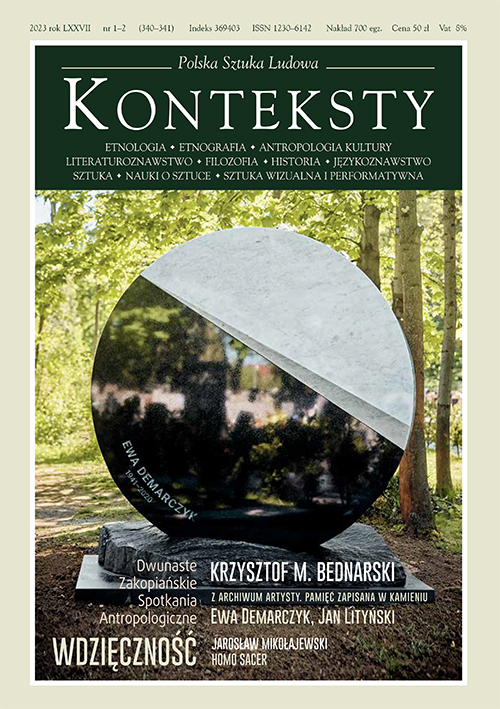Issue 2020/3 (330) - Archives - Wierszalin - Węgajty
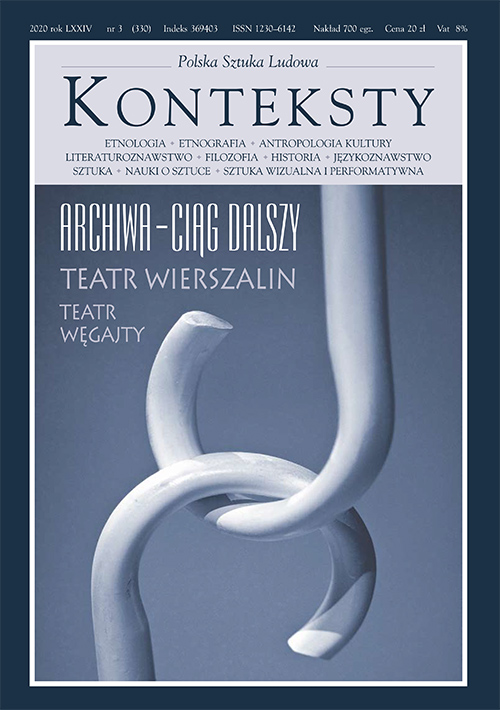
| Archives - continuation | ||
| Andrzej Franaszek | Maison de retraite  | 3 |
The author of the text closely follows the literary and painterly evidence of existential experience, i.a. the confrontation with one’s old age and the perspective of encroaching death, or, more precisely, a confrontation of the actual state associated with the end of life with its much earlier, youthful image. A presentation of an encounter of an old man and his decades younger self – a meeting that makes it possible to experience both personal identity and profound transformation taking place in the course of a lifetime. The interpretations are based on the literary works and reminiscences-testimonies by Aleksander Wat and Jarosław Iwaszkiewicz, as well as paintings by Józef Czapski. | ||
| Dorota Kownacka-Rogulska | Encounters in Art. Rainer Maria Rilke and Hugo von Hofmannsthal – a Distant Affiliation of Thought  | 11 |
At first glance Rainer Maria Rilke and Hugo von Hofmannsthal reveal numerous similarities – outstanding poets and men of letters, inept reviewers of art events, both Austrians by birth, closely connected the late nineteenth-century Vienna, and almost of the same age, they embarked upon themes associated with the reception and impact of art. Both men recalled the same artists, read the same books on art, and had an almost identical circle of acquaintances. Rilke developed his skills in front of an audience and experienced better or worse moments, including those of the poignant discomfort of prematurely announced and still immature lyrics. The more indrawn Hofmannsthal, fully developed and a perfectionist from his earliest literary attempt, maintained control over each broached theme and preserved a given convention. Even Julius Meyer-Graefe envied him aptness of statements about art phenomena. Both men of letters were continuators of a turnabout towards the unsaid. Both in their works tackled the crisis of the word, that characteristic fin de siècle re-evaluation of language. Both enhanced their workshop and literary vocabulary with observations of processes taking place in art. Their return to the word, however, disclosed two different paths of artistic development. Hofmannsthal turned towards social art by assiduously working for the sake of upholding the cultural legacy of his continent. Rilke turned towards non-engagée art by promoting l’art pour l’art, which opened a path towards modernity, with which he was unconcerned and which guaranteed him due memory. Hofmannsthal resigned from personal glory, being absorbed by cultivating national and communal identity so as to ensure a future continuum of historical empowerment. Apparently, the future moulded by Hofmannsthal did not appreciate the attraction of the stability and endurance promoted by the writer, and thrust into the whirlpool of a successive war rendered his universal strivings no longer current. There is the ever topical Rilke, more familiar to the Polish reader than Hofmannsthal, translated only in fragments and immersed in the history and culture of his people, both representing two, sometimes concurrent but basically different stands vis-à-vis existing reality. Regardless, or perhaps precisely for this reason, it is worth taking another look at those two creative stances. | ||
| Krzysztof M. Bednarski | From the Artist’s Archive 5: Sweat on Marble – My Poetic Inspirations  | 18 |
A fifth instalment from the From the Artist’s Archive series containing texts by an acclaimed sculptor and performer residing and working in Warsaw and Rome and commenting on his sculptures, exhibitions, and installations. In this part of the text the author describes the participation of poetry inspiring his works: In my oeuvre I frequently sought inspirations in literature and in particular in poetry. The list of poets to whom I dedicated my works is long. In secondary school I dedicated several compositions to Krzysztof Kamil Baczyński. This was a period when I signed my exercise books: Krzysztof Kamil Bednarski and was in love with Basia. Fortunately, I did not perish on a barricade of a successive failed uprising. I executed Landszaft bez boga (Godless Landscape, 1970) while listening to Wiersze wojenne (Wartime Poems) performed by Ewa Demarczyk. I owe the preservation of over ten youthful compositions on paper to my mother. I did not discover them until her death – she concealed them in a wardrobe under a pile of bed linen. At the time I closely followed the works of Rafał Wojaczek, Edward Stachura, and poets connected with the New Wave, i.a. Richard Krynicki, Adam Zagajewski, and Stanisław Barańczak; years later I dedicated to Barańczak my Popiół i papier, dwa sprzeczne zeznania (Ashes and Paper, Two Contradictory Confessions). Barańczak wrote this poem under the impact of the 1970 events at the Gdańsk shipyard. Popiół i papier… is a fish tank containing hairdressing pumps filled with ashes from a burnt “Gazeta Wyborcza” yearly (1991). This is what Stach Szabłowski wrote about it: ‘Bednarski encloses ashes within an aquarium, which becomes an urn containing the cremated body of a text. One can blow air into the interior of the glass receptacle with the help of a rubber pump. The air then lifts clouds of ashes; particles of the matter fill the space. If Bednarski’s work is close to poetry, then the conceit of the sculpture is inscribed between the lines of the composition – between the figures of destruction and transformation, the word and its absence, the cooperation of the spectator and distrust of meanings – as well as between art and politics’. This generation of poets – the author goes on – grew up on the experiences of March 1968 and December 1970. They undermined the sense of pursuing poetry in its heretofore form, and perceived duplicity and manipulation in every communiqué. I translated their awareness and distrust of the word into the language of sculpture. I also learned a lot from them; my political works contain an ambivalent message – they are not subjected to an unambiguous interpretation, nor are they publicistics and thus possess universal meaning. But I attached even more importance to the predecessors of the New Wave poets: Miron Białoszewski, Witold Wirpsza, and Tymoteusz Karpowicz, as well as Zbigniew Herbert, Czesław Miłosz, and Wisława Szymborska.” The artist’s years-long acquaintance with several poets turned into friendship, e.g. with Ryszard Krynicki and Jarosław Mikołajewski. “It is due to translations by Krynicki and Karpowicz that I discovered Celan, to whom I dedicated several exhibitions, i.a. Lying Down to Sleep in a Stranger’s Eye at the Polish Institute in Rome (2011) and Coraz więcej bieli / And Still More of the White at Galeria Foksal in Warsaw (2012). For this reason I dedicated the object: Die Niemandsrose / No Man’s Rose (1982) both to Paul Celan and Ryszard Krynicki. My key to the exhibition was the word: Erblinde, appearing often in Celan’s poetry as slowly progressing blindness, or, metaphorically speaking, oblivion. Erblinden means to become blind, i.e. to forget. In Celan’s poetry the motif of the eye and seeing, i.e. MEMORy, is omnipresent, just as at my exhibition. To become blind = to lose one’s memory.” I cannot omit also poets who exerted an impact on my works: Dante Alighieri, Adam Mickiewicz, Osip Mandelstam, Bruno Jasieński, Vladimir Mayakovsky, Thomas S. Eliot… Thanks to translations by Stanisław Barańczak I became acquainted with Dylan Thomas and found his Vision and Prayer particularly intriguing. I returned to this poem upon many occasions, but was unable to discover a suitable way of translating it into the language of matter. I am the author of an extensive series of compositions, whose form and structure were borrowed from a Dylan Thomas poem. Work on V & P was arduous and called for considerable discipline, which at the time proved to be my personal salvation. Thomas’ Vision and Prayer is construed upon a juxtaposition of contrasts, with the form of the first six lines depicting an urn-womb, while the further six – an hourglass-chalice. All is written down in the rigorous symmetry of versification and pertains to the fundamental cycle of transformations in man’s life: birth, death, and rebirth. Additionally, I performed a simple albeit significant reinterpretation of the entire cycle by combining the beginning of the poem and its end. In my reliefs the rhomboidal form and that of an hourglass meet interchangeably. All is consistently doubled. I also added a seventh part of the poem, absent in the original version, in the shape of a mandala composed of 12 double signs depicting the infinite cycle of eternal transformations. | ||
| Dariusz Czaja | Borges’ Dark Metaphysics. View via Judas / Through a Peephole  | 28 |
Despite several score mentions in the New Testament a generalised portrait of Judas still remains blurred and full of underspecified fragments. His intensified facial composite becomes involved in contradictions, and the fundamental body of testimonies can be rendered cohesive with difficulty. Even that, which for centuries has been recognised as certain (such as Judas’ Evangelical cognomen: “Iscariot”, “of Kerioth”), remains unclear. The keystone of the presented study is a brief text by Jorge Luis Borges: Three Versions of Judas, conventionally regarded as a short story. Here the narrative is treated as one of the fascinating and unorthodox voices in a centuries-old interpretation relay whose object is a person regarded as the greatest traitor in history. | ||
| Adam Mazur | The Last. The Jews of Kowno and Wilno in Photographs by Antanas Sutkus  | 42 |
This essay discusses a series of photographs by Antanas Sutkus depicting Jewish survivors from the ghettoes of Wilno (Vilnius) and Kowno (Kaunas). The series of black-and-white documentary photographs taken at the turn of the 1980s is an exceptional document and the artist’s first attempt of its kind to tackle history. A. Mazur presents the context of the origin and reception of the series, but also analyses the specific interpretation of the document by Sutkus, regarded as one of the most eminent Lithuanian photographers. | ||
| Aleksandra Kil, Jacek Małczyński, Dorota Wolska | A Tricky Case of Claude Lévi-Strauss’s Laboratoire d’anthropologie sociale: From the Archaeology of the Humanities Lab  | 48 |
A contemporary proliferation of an idea and institution of the humanities laboratory serves as a background for our case study of Laboratoire d’anthropologie sociale (LAS), founded in 1960 by Claude Lévi-Strauss. In this paper we examine three aspects of the LAS’ functioning: the significance of infrastructure (acquiring and using the Human Relations Area Files repository), experimenting (constructing models and mobiles) and collaboration (interpersonal relationships). LAS seems a forgotten initiative provoking questions as to an actual status of the humanities lab: is it merely an imitation of the natural sciences laboratory, or perhaps a rhetorical device employed by Lévi-Strauss aiming to gain academic prestige and benefits, or is it indeed a fully-fledged humanities laboratory fulfilling scientistic ambitions and aspirations of the structural anthropology? | ||
| Wiktor Stoczkowski | Social Sciences Theories as Visions of the World [Durkheim, Lévi-Strauss, Bourdieu, Latour]. Anthropological Reflections  | 54 |
We are accustomed to describing as beliefs conceptions that we do not believe while preserving the dignity of knowledge for conceptions that we believe without reservations. We are incapable, however, of proving the majority of ideas that we consider to be positive knowledge. Social science theories often belong precisely to this category: they become fashionable dogmas, and their authors – the object of a cult. Anthropology of culture provides us with tools enabling to explain the mechanism of this phenomenon. Taking as an example four known theories of the French social sciences (socio-anthropology by Émil Durkheim, structural anthropology by Claude Lévi-Strauss, sociology by Pierre Bourdieu, and symmetric anthropology by Bruno Latour) this article attempts to understand them as intellectual constructions endowed with an attraction whose force depends less on the scientific knowledge eventually contained therein, and more on the vision of the world proposed by those theories. The article is a supplemented version of a lecture given at the University of Warsaw in December 2018 as the Eighth Annual Anthropological Lecture in Memory of Professor Wierciński. | ||
| Lech Sokół | Institute of Art as Academia  | 64 |
I spent my entire scientific life at the Institute of Art of the Polish Academy of Sciences, where I started working on 1 April 1969. In this case April Fool’s Day proved to be extremely fortunate. Professor Juliusz Starzyński, at the time director of the Institute, employed me because already previously I studied the dramas of Stanisław Ignacy Witkiewicz (Witkacy), an outstanding avantgarde artist, playwright, critic, aesthete, and philosopher, and wrote an M.A. dissertation about Witkacy’s dramas in the light of his Pure Form theory. I presented an initial but coherent plan of a Ph.D. thesis, which the Professor found convincing. In this fashion Witkacy was my guide into the Institute of Art, where I work up to this day. Here I found all the necessary conditions to develop my comparatistic interests, which apart from drama and the theatre included the anthropology of culture, the visual arts, the cinema, and a smattering of musicology. Whenever I required consultations or assistance I never found scientific contacts with my colleagues representing the assorted disciplines pursued in our Institute to be a problem. Their knowledge was always “at hand”. Thus I was not compelled to search outside our institution in order to obtain necessary scientific support. In time, I too offered help regarding Scandinavian authors, predominantly Ibsen and Strindberg. This is the reason why I referred, and still do, to our Institute as an Academy – partly by evoking the ancient meaning of the word. | ||
| Anna Wiszniewska | Archive of Professor Irena Huml. Workshop of a Scholar and Art Critic  | 68 |
A description of the archive kept by Prof. Irena Huml for over 60 years of her activity as historian and art critic. This eminent researcher dealing with Polish twentieth-century applied arts and a specialist on so-called art of objects linked her entire professional life with the Institute of Art at the Polish Academy of Sciences in Warsaw. The private archive, collected for years, was posthumously handed over to the Special Collections at the afore-mentioned Institute of Art. The Prof. Irena Huml archive documents not solely the scholar’s scientific interests but also says a lot about her methods of work. Almost half of the total of archival units is composed of paper folders containing information about artists and designers dealing with applied arts. The resources in question include unique prints amassed for years in the course of scientific studies (exhibition catalogues, folders, posters), photographs of assorted artworks, sometime photographs of artists at work, manuscripts and typescripts of texts concerning their oeuvre, including unissued material, as well as interviews, anecdotes, and correspondence, often private-professional. One of the folios contains exclusively catalogues and photographs, others – handwritten biographies, projects, and letters, whose considerable parts refer to professional plans and conducted work, intermingled with information about private life, descriptions of vacations and the daily travails of an artist active at the time of the socialist shortage economy and associated difficulties with obtaining material indispensable for work. Further folios of the archival resource consist of material concerning Prof. Huml’s scientific work and organisational activity (i.a. a fond on the Gallery functioning alongside the Warsaw branch of the Women’s League): folios containing exhibition scenarios, and synopses of lectures and books). | ||
| Anna Agnieszka Szablowska | The Socialist Realism Archive at the Institute of Art of the Polish Academy of Sciences  | 73 |
Material comprising the discussed “socialist realism archive” is connected with the beginnings of the functioning of the Institute of Art of the Polish Academy of Sciences – IS PAN (at the time: the State Institute of Art) – a central scientific-research unit in which the foundations of new socialist realistic works were to emerge and consolidate. Alongside the creation of a world outlook superstructure one of the most prominent tasks of the institution established in 1949 was supervision over exhibitions of socialist realism and their documentation. Photographs registering socialist realism belong to a large collection known conventionally as the “photothèque of the fine arts” and encompass almost 8 000 first inventory numbers. They thus constitute the actual core of the present-day expanded and multi-theme Collections of Photographs and Survey Drawings. The axis of this set is composed of photographic records of four Pan-Polish Fine Arts Exhibitions – OWP (1950, 1951, 1952, 1954) as well as other key expositions of the Stalinist period. This is a unique collection owing to its complexity since it contains almost everything that was on show at the time and not only selected examples – a rare case of a concrete art phenomenon possessing its own closed archive created for the needs of a single institution. The set is composed not only of recently digitalised photographs but also written sources kept in the Special Collections and the Documentation of Polish Contemporary Art IS PAN. They include, i.a. ideologically steered interviews with artists, stenographic records from an international discussion conference dealing with OWP, and rough typescripts analysing concrete works from the viewpoint of their concurrence with the doctrine. No other scientific or museum institution possesses a similar collection. Digitally copied and universally accessible it opens new paths of research into art dating from the first five years of the 1950s, the centralised exhibition policy of the period, and the works of numerous celebrated artists but also totally forgotten ones. | ||
| Barbara Stępniewska-Holzer | “Those at the Top Are for Thinking, and Those at the Bottom Are for Listen-ing” Material Briefings of Heads of Voivodeship Offices, March 1948. Image of Lower Security Apparatus Cadres as Seen by the Head of the Ministry of Public Security in 1947–1956  | 79 |
Research focused on documents in the Security apparatus archive from the 1944–1954 period offers a depiction of relations between the Ministry and the local apparatus: voivodeship, county, and commune Security organs. Attempts at a reorganisation of the system of the functioning of the lowest links did not meet with the approval of the heads of the Ministry. The apparatus was regarded as inefficient and its size grew systematically. Nonetheless, the terror machine carried out its tasks of creating a new political and social system. Within this dialectic the “faulty” apparatus did not hamper the fulfilment of tasks imposed upon it, and thus was fully functional and useful. The creation of negative opinions about it “at the top” of the Ministry was a form of stimuli and pressure applied by superiors. | ||
| Wiktoria Tombarkiewicz | The Renascence of the Pantheonisation of Sacral Interiors in Contemporary Poland  | 86 |
Recent decades made it possible to notice the creation of new national pantheons in Roman Catholic churches across Poland. Pantheonisation was applied in the case of the St. Peter and Paul church in Cracow and the St. John cathedral in Warsaw; The Temple of Divine Providence in Wilanów also became a necropolis of eminent Poles. Symbolic pantheons, unconnected with a final resting place, have emerged and continue to be created – take the example of the one decorating the chancel arch wall in the Sanctuary of the Blessed Virgin Mary Star of the New Evangelization and St. John Paul II in Toruń or the Upper Silesian Pantheon under construction in the crypts of the arch cathedral of Christ the King in Katowice. Pantheons are part of a tradition initiated in Rome, where the church of Santa Maria ad Martyres, place of the eternal rest of Raphael, became a necropolis of artists belonging to the St. Joseph Fraternity. In time, other Italian and then European towns erected similar cult sites commemorating great men, originally with a local range and then also a state one. From the nineteenth centre on national pantheons began to constitute an essential carrier of the national discourse, building a vision of the history of imaginary communities. | ||
| Paweł Bem | Duties and Ambitions. Once More on the Non-Memory of the Poet  | 98 |
A presentation of the relation of several handwritten notes by Czesław Miłosz containing his novel Zdobycie władzy (The Seizure of Power). The connection of those texts, the recognition of the concurrence of their contents, and reflections on their textological status become a successive contribution to a discussion about the poet’s “poetic memory” and ways of commemorating victims of the Holocaust in literature. | ||
| Wierszalin Theatre | ||
| Tomasz Wiśniewski | “Suspicions Concerning the Human Nature”. A conversation with Piotr Tomaszuk  | 107 |
In this conversation Piotr Tomaszuk discusses one of his recent production called “Faustus. A New History”. Based on translations of various versions of the myth (Christopher Marlow, Johann Wolfgang Goethe and August Klingemann), the play explores most profound depths of human nature in the past and in the present. | ||
| Zbigniew Majchrowski | Soothsayer from Wierszalin  | 113 |
Contrary to predictions about the twilight of the “Romantic paradigm” in the process of the post-1989 transformation it is still possible to speak about the “long duration” of Romanticism in the contemporary Polish theatre. Teatr Wierszalin in Supraśl has its own geo-poetics, and in the two-part production of Dziady (Forefathers’ Eve) by Adam Mickiewicz, directed by Piotr Tomaszuk (Noc pierwsza / First Night – 2016, Noc druga / Second Night – 2017) the borderline nature of genius loci is to be heard in the syncretic music setting, harmonising with Eastern Orthodox and Jewish stylisations. Nevertheless, music rather universalises the message since Tomaszuk avoids folklorisation and does not create an aura of folk authenticity or an ethnographic epigraph. There is no peasant group in his Dziady. This absence of peasants – even if enforced by the limited size of the ensemble – has to be significant; otherwise what would the Soothsayer be without them? The director assumes that there is no simple return to rituals of the past, because the integrative function of folk culture has been taken over by mass culture. How is the spectator to believe in theatrical phantoms if he does not believe in ghosts and only watches horror movies? – Tomaszuk appears to be asking. What is the meaning of “Restore Dziady to us” in the present-day theatre if a return to a ritual community does not appear to be possible? The Soothsayer has to change if he is not to be an archaic folk guru. Among all the dramatis personae in Dziady it is precisely the stage embodiment of the Soothsayer that most often underwent re-interpretation, and it is in his stage image that the dynamics of social reconstruction and the transformation of the collective imaginarium were reflected the strongest. In successive stagings the Soothsayer was shown in assorted ways: as a clocharde, a leader of social outcasts, a female psychotherapist, and a semblance of the comic-book Joker. In Teatr Wierszalin the foundation of the part of the Soothsayer according to the director’s and actor’s interpretation proposed by Tomaszuk is composed of a conception of the artist as a memory medium. The Soothsayer / Poet performs his ritual alone, without the participation of the gathered peasants. The author of this article interprets the director’s staging intention as a resignation from an attempt at a restitution of the ritual and an affirmation precisely of the theatre – quite possibly the only place for the celebration of Forefathers’ Eve comprehended not in museum-ethnographic terms but as a semblance of the “memory sense” created by Tadeusz Kantor in Umarła klasa (Dead Class) shown by Teatr Cricot 2 (1975). Dziady at Teatr Wierszalin is a private, personal ritual – no longer held in a cemetery but in a crypt of inner life: a meeting with the sort of phantoms that haunt memory. | ||
| Agnieszka Bednarek-Bohdziewicz, Janusz Bohdziewicz | God – the People’s Playground. Theodramaturgy according to Teatr Wierszalin  | 123 |
The objective of this essay is to reflect on the religious dimension of the activity of Teatr Wierszalin in Supraśl. The presented sketch deals with several selected spectacles (Historyja o chwalebnym zmartwychwstaniu Pańskim / History of the Glorious Resurrection of Our Lord, Dziady – Noc Pierwsza i Druga / Forefathers’ Eve – First and Second Night and Bóg Niżyński / God Nijinsky), interpreted in reference to all the efforts of the ensemble and within the context of the social and aesthetic thought of Adam Mickiewicz; the study also corresponds with the theological works of Hans Urs von Balthasar and the aesthetic theories of George Steiner and Hans Ulrich Gumbrecht. Wierszalin appears to be an anthropological theatre deeply immersed in the tradition of the place of its activity and the history of staged plays, which with great acuteness undertake the problems of human spirituality at odds with corporeality, and relations between that primary human existential experience and the doctrines and institutions of Christian Churches. On stage this problem range is expressed predominantly by an intense presentation of differences between the actor’s actual corporeality and the multi-strata message of meanings from the past: the presence of the actor is more important than the text, and all meaning can be deciphered only thanks to the energy of concrete persons, who bring it up to date in the course of a meeting with the public. The poetics of spectacles described in the article carries a possible interpretation of Christianity as an interchangeable part played by God and man. | ||
| Mirosława Modrzewska | The Polish Microcosmos According to Teatr Wierszalin and the Global Addressee  | 133 |
The author of the article attempts to explain the successful reception of the Wierszalin Theatre in the West by using the example of Dziady – Noc pierwsza and Noc druga (Forefathers’ Eve – First Night and Second Night) directed by Piotr Tomaszuk. In order to do so she uses the concept of a “global addressee”, that is an English speaking addressee with at least a basic knowledge of the European history of literature, drama, and theatre of the nineteenth and twentieth century. The author demonstrates that despite the specifically local colour of the Polish drama by Adam Mickiewicz as well as its theatre adaptation by Wierszalin, the production is deeply rooted in the European tradition of the Romantic mystery play, especially well-known from the lyrical and confessional dramas by George Gordon Byron and followed by the so-called “poor theatre” of the twentieth century as well as the “theatre of death” by Tadeusz Kantor. | ||
| Barbara Świąder-Puchowska | A New Puppet Drama. On Piotr Tomaszuk in Gdańsk  | 139 |
On Piotr Tomaszuk in Gdańsk The article describes initial phase in the creation of Teatr Wierszalin, when together with Tadeusz Słobodzianek and a group of actors, Piotr Tomaszuk insisted on creating a new ethos of work in theatre. This happened in Gdańsk (Teatr Miniatura) before Teatr Wierszalin started to function officially in Supraśl. | ||
| Alicja Bral | A Short History of the “First Wierszalin”. 1991–2000  | 147 |
The article describes the transformations of an institution, i.e. Teatr Wierszalin, from its establishment in 1991 and change into a Foundation in 1997 to the moment it became a state institution. The synergy of culture and politics and – putting it in lofty terms – the “business venture” are exampled by Wierszalin’s new way of thinking about art, which the article tries to illustrate. While describing this phenomenon the author endeavours to take a particularly careful look at spectacles and their reception since, as is known, it is they that are the heart of the theatre. With this purpose in mind A. Bral evoked the contents of the dramas and took into account critics’ reviews. | ||
| Barbara Świąder-Puchowska | Body and Sacrum. On Bóg Niżyński by Piotr Tomaszuk  | 161 |
Presentation of a multi-aspect analysis of Piotr Tomaszuk’s auteur spectacle: Bóg Niżyński (God Nijinsky) from 2006. The author discusses the realisation proposed by Teatr Wierszalin, i.a. within the context of the titular artist’s biography, in particular the experience of mental illness, his greatest stage creations (in Petrushka, The Afternoon of a Faun, and The Rite of Spring), and the dancer’s relationship with Sergei Diaghilev, founder of Ballets Russes, whose person becomes of key importance for Tomaszuk. The author of the article situates the Tomaszuk spectacle in, i.a. the context of earlier cultural texts also dedicated to Nijinsky. Moreover, she indicates that the drama and spectacle inspired by Nijinsky’s Journal embarks upon themes significant in the Tomaszuk oeuvre: faith and saintliness, sin and repentance, the possibility of conversion and forgiveness, and pure and unclean love, also in its bodily dimension – mystic and erotic, shown in the body of the dancer-God as a meeting place of the sacrum and the profanum, i.a. via analogies to the Passion of Christ and the despair of Petrushka. Next, the author writes about the means applied by the director (including those of the actors, in particular regarding the performer of the lead part – Rafał Gąsowski) indicating, i.a. references to the works of Tadeusz Kantor and Jerzy Grotowski. Finally, she undertakes an attempt at analysing elements construing Tomaszuk’s blasphemous Passion spectacle inscribed into the composition of a ritual, liturgy à rebours, including references to a sacrilegiously re-fashioned Eastern Orthodox memorial service – the panikhida, with Nijinsky as priest and, at the same time, God. | ||
| Katarzyna Siergiej | Experiencing Unhampered Freedom. On Preparing the Part of Olga D. in “Wierszalin. Reportaż o końcu świata”  | 167 |
Presentation of the acting experiences of Katarzyna Siergiej connected with the creation of the part of Olga D. in the spectacle Wierszalin. Reportaż o końcu świata (Wierszalin. A Report on the End of the World). The author considers selected aspects of the creative work of Teatr Wierszalin, associated predominantly with the stage adaptation of Włodzimierz Pawluczuk’s book. Mention is made both of the forms of actor’s expression, the dynamics of working on the text, the role played by music, and, first and foremost, the specificity of the actors’ ensemble emerging in the course of the rehearsals. An essential part was also performed by the spectacle score designating the range of artistic tasks and moulding its sense. The author / actress stresses that working on the role of Olga D. made her aware of the part played by the theatre of the form in attaining totally unrestricted stage freedom. | ||
| Katarzyna Siergiej | Spectacle from the Actor’s Perspective: “Wierszalin. Reportaż o końcu świata” by Piotr Tomaszuk  | 176 |
The article describes the spectacle Wierszalin. Reportaż o końcu świata (Wierszalin. A Report on the End of the World), directed by Piotr Tomaszuk, with particular attention paid to the staging perspective. The premiere was held in May 2007 at Teatr Wierszalin, and the author took an active part in its preparation both as an actress and, at the same time, creator of one of the leads. The article takes into account the evolution of the spectacle – the consequence of its long exploitation (eight seasons) and changes of the cast. Modifications of staging were the outcome predominantly of the style of the work carried out by the director (of the show and the theatre company), who demands creativity from actors – long-term members of the troupe and those recently introduced into the cast. | ||
| Tomasz Wiśniewski | Good Ready-Made Tools – a conversation with Katarzyna Siergiej  | 189 |
In this 2013 conversation, Katarzyna Siergiej, who was then one of the leading actresses in Teatr Wierszalin, describes her contribution to the company’s work. She also speaks about notions such as improvisation and role of an actor in the ensemble. | ||
| Tomasz Wiśniewski | Objects of No Use to Anyone Else – a conversation with Dariusz Matys  | 191 |
In this 2013 conversation, Dariusz Matys – one of the leading actors of Teatr Wierszalin, speaks about the local background of the company and the exceptional role of stage design. | ||
| Tomasz Wiśniewski | The Four Faces of Teatr Wierszalin  | 193 |
The article concentrates on four different aspects of Teatr Wierszalin, namely: its debt to the tradition of Polish theatre, its affinities with the local problems of eastern Poland, insistent exploration of theatrical potential and fascination with ambiguities of religious notions. It is argued Piotr Tomaszuk has managed to create specific theatrical language that is consistently employed by Teatr Wierszalin. | ||
| Joanna Puzyna-Chojka | Recollections in a “Dead Class”. “Historyja o chwalebnym Zmartwychwstaniu Pańskim” by Mikołaj of Wilkowiecko at Teatr Wierszalin in Relation to Staging Tradition  | 199 |
Analysis of the staging of Historyja o chwalebnym Zmartwychwstaniu Pańskim (History of the Glorious Resurrection of Our Lord), a drama by Mikołaj of Wilkowiecko, prepared by Piotr Tomaszuk at Teatr Wierszalin with reference to the varied tradition of staging this play in the Polish theatre and in particular three interpretations proposed by outstanding directors-authors of adaptations: Leon Schiller (Teatr Reduta in Warsaw, 1923), Kazimierz Dejmek (Teatr Nowy in Łódź, 1961; Teatr Narodowy in Warsaw, 1962) and Piotr Cieplak (Teatr Współczesny im. Edmunda Wiercińskiego in Wrocław, 1993; Teatr Dramatyczny in Warsaw, 1994). By analysing the Piotr Tomaszuk staging at Teatr Wierszalin the author also points to inspiration sought in the aesthetics of Tadeusz Kantor’s Theatre of Death. | ||
| Żaneta Nalewajk | Drama and Theatre on the Border of Worlds. The Meeting of Piotr Tomaszuk and the Wierszalin Theatre with Stanisław Wyspiański  | 205 |
The main goal of this article is to present a comparative study on the tragedies Sędziowie / Judges written by Stanisław Wyspiański, one of the most famous playwrights of Polish modernism, and Teatr, którego nie było / Theatre That Never Was by Piotr Tomaszuk (inspired by the Wyspiański drama) and its production by the Wierszalin Theatre. The author focuses on the form and most important problems of these dramatic and theatrical works by discussing their metadramatical and metatheatrical aspects, and considering the issue of guilt and co-guilt referred to in the Bible and Greek tragedy while showing it as a current model exposing the mechanisms of human action. | ||
| Piotr Tomaszuk | The Theatre That Has Never Been  | 215 |
The Theatre That Has Never Been… is a play by Piotr Tomaszuk that was inspired by The Judges, a 1907 drama by Stanisław Wyspiański. Tomaszuk introduces a hypothetic conversation of Wyspiański with Ludwik Solski, the director of Teatr Miejski in Kraków, about a possibility of staging the play. | ||
| Węgajty Theatre | ||
| Magdalena Hasiuk | Ethos and utopia in the activities of Teatr Węgajty  | 226 |
In the presented text, the Węgajty Theater’s characteristic work method was analyzed taking into account such categories as: “environment”, “colony”, “ethos” (with the key recognition of Józef Tischner) and “ecotone” (introduced for humanities research in Poland by Ewa Kępa). The text is an attempt to answer the question how the ethos of the Węgajty Theater and the ethics of its work result from the occupied place (an abandoned habitat outside the Warmian village); and how all these factors determine the type of theatrical work and artistic activities undertaken in Węgajty. Their singular example is the international Theater Village Festival seen in the text in terms of utopia in reference to the works of Howard Becker, Michèle Madonna-Desbazeille, Alain Passin, Jean Duvignaud and the recognition of Edwin Bendyk. | ||
| Kamila Morawska | Eternal Longings for Paradise, or the Eternal Need of Being. A Commentary to the Polish Edition of “Á la recherche du paradis” by Jean Delumeau  | 237 |
What does contemporary man long for? What is the object of his desire? What constitutes his Paradise? These questions – posed principally today, in an age of an authentic political, economic, and social crisis pertaining to the “to be or not to be” of mankind and the world – are by no means unsubstantiated. The author discusses the significance of works by Jean Delumeau, and in particular Á la recherche du paradis (2010), recently translated into Polish and published. In the wake of three capacious volumes dedicated to “quests in the domain of hope”, i.e. Le Jardin des délices (1992), Mille ans de bonheur (1995), and Que reste-t-il du paradis? (2000), their author opted for ostensibly somewhat lighter matter, namely, the sphere of the imagination and its images. Delumeau deals with, and has fun with symbols and images, decoding the meanings of assorted representations of Paradise. | ||










